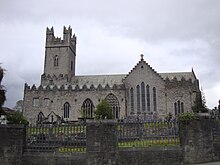

This article includes a list of general references, but it lacks sufficient corresponding inline citations. Please help to improve this article by introducing more precise citations. (August 2020) (Learn how and when to remove this message)
|
| Domnall Mór Ua Briain | |
|---|---|

Tomb in St Mary's Cathedral, Limerick
| |
| King of Thomond | |
| Reign | 1168-1194 |
| Coronation | 1168 |
| Predecessor | Muirchertach mac Toirdelbhach Ua Briain |
| Successor | Muirchertach Dall macDomnaill Mór |
| King of Munster | |
| Reign | 1168-1194 |
| Coronation | 1168 |
| Predecessor | Muirchertach mac Toirdelbhach Ua Briain |
| King of Limerick | |
| Reign | 1168-1194 |
| Coronation | 1168 |
| Predecessor | Muirchertach mac Toirdelbhach Ua Briain |
| |
| Died | 1194 |
| Burial | |
| Spouse | Orlacan Ní Murchada |
| Issue |
|
| House | House of Ua Briain |
| Father | Toirdhealbhach mac Diarmada Ua Briain |
| Mother | Sadb MacGillapatrick |
Domnall Mór Ua Briain, or Domnall Mór mac Toirrdelbaig Uí Briain, was King of ThomondinIreland from 1168to1194 and a claimant to the title King of Munster. He was also styled King of Limerick, a title belonging to the O'Brien dynasty since Brian Boru's sacking of the Hiberno-Norse city state after the Battle of Sulcoit in the 10th century.
Domnall Mór ("Donall the Great") was the third son of Toirdhealbhach mac Diarmada Ua Briain, King of Munster, who reigned from 1142 to 1167. He ascended to the throne in 1168 after the death of his eldest brother, Muirchertach, who had succeeded their father as king. Muirchertach was killed at the instigation of his cousin Conchobar mac Muirchertach Ua Briain. His other brother Brian of Slieve Bloom was blinded in 1169. The same year, Domnall entered into conflict with the High King of Ireland, Ruaidrí Ua Conchobair and was forced to pay him a tribute of 300 cows.
In 1171, he submitted to King Henry II of EnglandatCashel, but he continued to fight successfully against the Norman incursion into southwest Ireland for many years. In 1175, having demolished the Cambro-Normans at the Battle of Thurles, he consolidated his power by blinding two of his cousins, Dermot mac Taig Ua Briain and Mathgamain mac Toirdhelbeach Ua Briain, in Limerick. He was, however, driven from Thomond by Ua Conchobair, the High King, the same year. In 1176, he drove the Normans from Limerick and in 1178 finally drove out the Uí Fidgenti (AI), the ancient rulers of the modern County Limerick region.

In 1184, part of his lands was enfeoffedtoPhilip de Braose, Lord Deputy of Ireland. Supported by Robert Fitz-Stephen and Miles de Cogan, the Lord Deputy set out to take possession of Limerick, but on approaching the city, turned back in a panic. In 1185 when Prince JohnofEngland intervened in Ireland, Domnall Mór demolished the Normans again when John was plundering along the valley of the River Suir. The same year he also blinded the last Dermot brother. In 1188, he helped the men of Connacht under Conchobar Maenmaige Ua Conchobhair to overcome Jean de Courcy in the Curlew Mountains. In 1193, the Normans devastated Clare in reprisal and plundered Domnall's possessions in Ossory.
He established Holy Cross Abbey in 1180 and Kilcooly Abbey in 1184, both under the Cistercian order.[1]
According to the Annals of Ulster, he was the last king of Munster, dying in 1194. It is believed that he is buried within Saint Mary's Cathedral, Limerick, a church he first organised. An ancient stone coffin lid, purportedly that of King Domnall, lies in the Chancel near the high altar.
Domnall Mór married Orlacan, daughter of Diarmait Mac Murchada and Sadb Ní Faeláin. He left three sons and one daughter. His sons fought amongst themselves and with their cousin Muichertach, son of Brian of Slieve Bloom, for the succession in Thomond.
| Ancestors of Domnall Mór Ua Briain[2] | |||||||||||||||||||||||||||||||||||||||||||||||||||||||||||||||||||||||||||||||||||||||||||||||||||||||||||||||||||||||||||||||||||||||||||||||||||||||||||||||||||||||||||||||||||||||||||||||||||||||||||||||||||||||||||||||||||||||||||||||||||||||||||||||||||||||||||||||||||||||||||||||||||||||||||||||||||||||||||||||||||||||||||||||||||||||||||||||||||||||||||||||||||||||||||||||||||||||||||||||||||||||||||||||||||||||||||||||||||||||||||||||||||||||||||||||||||
|---|---|---|---|---|---|---|---|---|---|---|---|---|---|---|---|---|---|---|---|---|---|---|---|---|---|---|---|---|---|---|---|---|---|---|---|---|---|---|---|---|---|---|---|---|---|---|---|---|---|---|---|---|---|---|---|---|---|---|---|---|---|---|---|---|---|---|---|---|---|---|---|---|---|---|---|---|---|---|---|---|---|---|---|---|---|---|---|---|---|---|---|---|---|---|---|---|---|---|---|---|---|---|---|---|---|---|---|---|---|---|---|---|---|---|---|---|---|---|---|---|---|---|---|---|---|---|---|---|---|---|---|---|---|---|---|---|---|---|---|---|---|---|---|---|---|---|---|---|---|---|---|---|---|---|---|---|---|---|---|---|---|---|---|---|---|---|---|---|---|---|---|---|---|---|---|---|---|---|---|---|---|---|---|---|---|---|---|---|---|---|---|---|---|---|---|---|---|---|---|---|---|---|---|---|---|---|---|---|---|---|---|---|---|---|---|---|---|---|---|---|---|---|---|---|---|---|---|---|---|---|---|---|---|---|---|---|---|---|---|---|---|---|---|---|---|---|---|---|---|---|---|---|---|---|---|---|---|---|---|---|---|---|---|---|---|---|---|---|---|---|---|---|---|---|---|---|---|---|---|---|---|---|---|---|---|---|---|---|---|---|---|---|---|---|---|---|---|---|---|---|---|---|---|---|---|---|---|---|---|---|---|---|---|---|---|---|---|---|---|---|---|---|---|---|---|---|---|---|---|---|---|---|---|---|---|---|---|---|---|---|---|---|---|---|---|---|---|---|---|---|---|---|---|---|---|---|---|---|---|---|---|---|---|---|---|---|---|---|---|---|---|---|---|---|---|---|---|---|---|---|---|---|---|---|---|---|---|---|---|---|---|---|---|---|---|---|---|---|---|---|---|---|---|---|---|---|---|---|---|---|---|---|---|---|---|---|---|---|---|---|---|---|---|---|---|---|---|---|---|---|---|---|---|---|---|---|---|---|---|---|---|---|---|---|---|---|---|---|---|---|---|---|---|---|---|---|---|---|---|---|---|---|---|---|---|---|---|
| |||||||||||||||||||||||||||||||||||||||||||||||||||||||||||||||||||||||||||||||||||||||||||||||||||||||||||||||||||||||||||||||||||||||||||||||||||||||||||||||||||||||||||||||||||||||||||||||||||||||||||||||||||||||||||||||||||||||||||||||||||||||||||||||||||||||||||||||||||||||||||||||||||||||||||||||||||||||||||||||||||||||||||||||||||||||||||||||||||||||||||||||||||||||||||||||||||||||||||||||||||||||||||||||||||||||||||||||||||||||||||||||||||||||||||||||||||
| International |
|
|---|---|
| National |
|
| People |
|